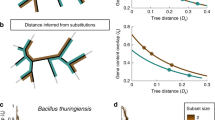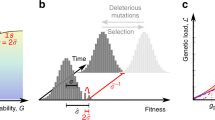Abstract
The evolution of bacterial and archaeal genomes is highly dynamic and involves extensive horizontal gene transfer and gene loss1–4. Furthermore, many microbial species appear to have open pangenomes, where each newly sequenced genome contains more than 10% ORFans, that is, genes without detectable homologues in other species5,6. Here, we report a quantitative analysis of microbial genome evolution by fitting the parameters of a simple, steady-state evolutionary model to the comparative genomic data on the gene content and gene order similarity between archaeal genomes. The results reveal two sharply distinct classes of microbial genes, one of which is characterized by effectively instantaneous gene replacement, and the other consists of genes with finite, distributed replacement rates. These findings imply a conservative estimate of the size of the prokaryotic genomic universe, which appears to consist of at least a billion distinct genes. Furthermore, the same distribution of constraints is shown to govern the evolution of gene complement and gene order, without the need to invoke long-range conservation or the selfish operon concept7.
This is a preview of subscription content, access via your institution
Access options
Subscribe to this journal
Receive 12 digital issues and online access to articles
$119.00 per year
only $9.92 per issue
Buy this article
- Purchase on Springer Link
- Instant access to full article PDF
Prices may be subject to local taxes which are calculated during checkout



Similar content being viewed by others
Change history
14 July 2017
In the PDF version of this article previously published, the year of publication provided in the footer of each page and in the 'How to cite' section was erroneously given as 2017, it should have been 2016. This error has now been corrected. The HTML version of the article was not affected.
References
Mushegian, A. R. & Koonin, E. V. A minimal gene set for cellular life derived by comparison of complete bacterial genomes [see comments]. Proc. Natl Acad. Sci. USA 93, 10268–10273 (1996).
Kolstø, A. B. Dynamic bacterial genome organization. Mol. Microbiol. 24, 241–248 (1997).
Koonin, E. V. Comparative genomics, minimal gene-sets and the last universal common ancestor. Nat. Rev. Microbiol. 1, 127–136 (2003).
Koonin, E. V. & Wolf, Y. I. Genomics of bacteria and archaea: the emerging dynamic view of the prokaryotic world. Nucleic Acids Res. 36, 6688–6719 (2008).
Daubin, V. & Ochman, H. Bacterial genomes as new gene homes: the genealogy of ORFans in E. coli. Genome Res. 14, 1036–1042 (2004).
Yin, Y. & Fischer, D. On the origin of microbial ORFans: quantifying the strength of the evidence for viral lateral transfer. BMC Evol. Biol. 6, 63 (2006).
Lawrence, J. Selfish operons: the evolutionary impact of gene clustering in prokaryotes and eukaryotes. Curr. Opin. Genet. Dev. 9, 642–648 (1999).
Makarova, K. S., Wolf, Y. I. & Koonin, E. V. Archaeal clusters of orthologous genes (arCOGs): an update and application for analysis of shared features between Thermococcales, Methanococcales, and Methanobacteriales. Life (Basel) 5, 818–840 (2015).
Medini, D. et al. Microbiology in the post-genomic era. Nat. Rev. Microbiol. 6, 419–430 (2008).
Haegeman, B. & Weitz, J. S. A neutral theory of genome evolution and the frequency distribution of genes. BMC Genomics 13, 196 (2012).
Baumdicker, F., Hess, W. R. & Pfaffelhuber, P. The infinitely many genes model for the distributed genome of bacteria. Genome Biol. Evol. 4, 443–456 (2012).
Collins, R. E. & Higgs, P. G. Testing the infinitely many genes model for the evolution of the bacterial core genome and pangenome. Mol. Biol. Evol. 29, 3413–3425 (2012).
Lobkovsky, A. E., Wolf, Y. I. & Koonin, E. V. Gene frequency distributions reject a neutral model of genome evolution. Genome Biol. Evol. 5, 233–242 (2013).
Krylov, D. M., Wolf, Y. I., Rogozin, I. B. & Koonin, E. V. Gene loss, protein sequence divergence, gene dispensability, expression level, and interactivity are correlated in eukaryotic evolution. Genome Res. 13, 2229–2235 (2003).
Wolf, Y. I., Carmel, L. & Koonin, E. V. Unifying measures of gene function and evolution. Proc. Biol. Sci. 273, 1507–1515 (2006).
Dagan, T. & Martin, W. Ancestral genome sizes specify the minimum rate of lateral gene transfer during prokaryote evolution. Proc. Natl Acad. Sci. USA 104, 870–875 (2007).
Koonin, E. V. & Wolf, Y. I. Evolutionary systems biology links between gene evolution and function. Curr. Opin. Biotechnol. 17, 481–487 (2006).
Wolf, Y. I. Coping with the quantitative genomics ‘elephant’: the correlation between the gene dispensability and evolution rate. Trends Genet. 22, 354–357 (2006).
Lawrence, J. G. & Roth, J. R. Selfish operons: horizontal transfer may drive the evolution of gene clusters. Genetics 143, 1843–1860 (1996).
Wilson, G. A. et al. Orphans as taxonomically restricted and ecologically important genes. Microbiology 151, 2499–2501 (2005).
Yu, G. & Stoltzfus, A. Population diversity of ORFan genes in Escherichia coli. Genome Biol. Evol. 4, 1176–1187 (2012).
Lobb, B., Kurtz, D. A., Moreno-Hagelsieb, G. & Doxey, A. C. Remote homology and the functions of metagenomic dark matter. Front. Genet. 6, 234 (2015).
Ochman, H., Lawrence, J. G. & Groisman, E. A. Lateral gene transfer and the nature of bacterial innovation. Nature 405, 299–304 (2000).
Cortez, D., Forterre, P. & Gribaldo, S. A hidden reservoir of integrative elements is the major source of recently acquired foreign genes and ORFans in archaeal and bacterial genomes. Genome Biol. 10, R65 (2009).
Iranzo, J., Puigbo, P., Lobkovsky, A. E., Wolf, Y. I. & Koonin, E. V. Inevitability of genetic parasites. Genome Biol. Evol. 8, 2856–2869 (2016).
Curtis, T. P., Sloan, W. T. & Scannell, J. W. Estimating prokaryotic diversity and its limits. Proc. Natl Acad. Sci. USA 99, 10494–10499 (2002).
Locey, K. J. & Lennon, J. T. Scaling laws predict global microbial diversity. Proc. Natl Acad. Sci. USA 113, 5970–5975 (2016).
Vernikos, G., Medini, D., Riley, D. R. & Tettelin, H. Ten years of pan-genome analyses. Curr. Opin. Microbiol. 23, 148–154 (2015).
Tettelin, H., Riley, D., Cattuto, C. & Medini, D. Comparative genomics: the bacterial pan-genome. Curr. Opin. Microbiol. 11, 472–477 (2008).
Puigbò, P., Lobkovsky, A. E., Kristensen, D. M., Wolf, Y. I. & Koonin, E. V. Genomes in turmoil: quantification of genome dynamics in prokaryote supergenomes. BMC Biol. 12, 66 (2014).
Wolf, Y. I., Novichkov, P. S., Karev, G. P., Koonin, E. V. & Lipman, D. J. The universal distribution of evolutionary rates of genes and distinct characteristics of eukaryotic genes of different apparent ages. Proc. Natl Acad. Sci. USA 106, 7273–7280 (2009).
Yang, Z. Maximum-likelihood estimation of phylogeny from DNA sequences when substitution rates differ over sites. Mol. Biol. Evol. 10, 1396–1401 (1993).
Kimura, M. Model of effectively neutral mutations in which selective constraint is incorporated. Proc. Natl Acad. Sci. USA 76, 3440–3444 (1979).
Creevey, C. J. et al. Does a tree-like phylogeny only exist at the tips in the prokaryotes? Proc. Biol. Sci. 271, 2551–2558 (2004).
Cleveland, W. S. & Devlin, S. J. Locally-weighted regression: an approach to regression analysis by local fitting. J. Am. Stat. Assoc. 83, 596–610 (1988).
Acknowledgements
The authors thank P. Higgs (McMaster University), J. Iranzo (NCBI, NIH) and D. Kristensen (NCBI; currently, University of Iowa) for discussions. The authors' research is supported by intramural funds of the US Department of Health and Human Services (to the National Library of Medicine).
Author information
Authors and Affiliations
Contributions
Y.I.W. and E.V.K. conceived the study. Y.I.W. performed research. Y.I.W., K.S.M., A.E.L. and E.V.K. analysed the results. Y.I.W. and E.V.K. wrote the manuscript, which was read, edited and approved by all authors.
Corresponding author
Ethics declarations
Competing interests
The authors declare no competing financial interests.
Supplementary information
Supplementary information
Supplementary Figures 1–15, Supplementary Table 1 (PDF 2154 kb)
Rights and permissions
About this article
Cite this article
Wolf, Y., Makarova, K., Lobkovsky, A. et al. Two fundamentally different classes of microbial genes. Nat Microbiol 2, 16208 (2017). https://doi.org/10.1038/nmicrobiol.2016.208
Received:
Accepted:
Published:
DOI: https://doi.org/10.1038/nmicrobiol.2016.208
This article is cited by
-
Pseudogenes act as a neutral reference for detecting selection in prokaryotic pangenomes
Nature Ecology & Evolution (2024)
-
A global survey of prokaryotic genomes reveals the eco-evolutionary pressures driving horizontal gene transfer
Nature Ecology & Evolution (2024)
-
Towards the biogeography of prokaryotic genes
Nature (2022)
-
Assessment of assumptions underlying models of prokaryotic pangenome evolution
BMC Biology (2021)
-
Micro-evolution of three Streptococcus species: selection, antigenic variation, and horizontal gene inflow
BMC Evolutionary Biology (2019)



